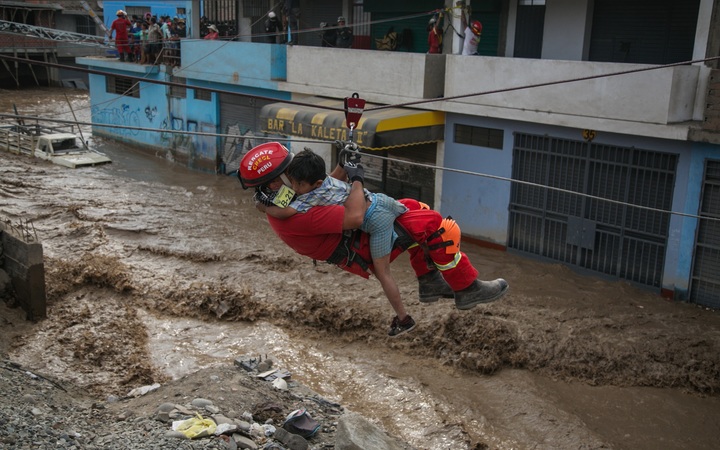
 The OAS Sustainable Cities Course in Miraflores, Peru—an affluent district within the sprawling capital city of Lima—was supposed to take place in March. Then came the punishing rains and floods brought by an especially severe version of a localized climate phenomenon known as a “Coastal El Niño.” The course took place April 19-22 instead, with the importance of sustainable cities and resilience to hazards still fresh on participants’ minds. (Photo: AFP)
The OAS Sustainable Cities Course in Miraflores, Peru—an affluent district within the sprawling capital city of Lima—was supposed to take place in March. Then came the punishing rains and floods brought by an especially severe version of a localized climate phenomenon known as a “Coastal El Niño.” The course took place April 19-22 instead, with the importance of sustainable cities and resilience to hazards still fresh on participants’ minds. (Photo: AFP)Richard Huber, Chief of the OAS Sustainable Communities, Hazard Risk, and Climate Change Section, said the backdrop of the recent flooding made the substance of the course especially pertinent. “Issues of resilience, hazard preparations, and early warning systems took on more urgency because people were actually living it,” he said.
The flooding in Peru left more than 100 people dead and upended the lives of hundreds of thousands of others. Homes and crops were destroyed, and government officials estimated in late March that it would take at least $1 billion to repair the damage to roads and bridges.
Miraflores itself did not take a direct hit—though the city was without drinking water for several days—but parts of Lima and many areas in northern Peru were devastated.
“It was a very difficult time for the country,” explained Pamela Lucía Bravo Ortiz, Deputy Director of Environmental Development for the municipality of Miraflores. The decision to postpone the course was made partly because many participants from other regions of Peru would be unable to travel to Lima due to the widespread flooding and mudslides known as huaicos, she said.
In Miraflores, meanwhile, the cutoff of drinking water—the result of storm-related damage to a major water treatment plant in Lima—brought home the need to take care of a valuable resource, use it wisely, and reuse it whenever possible, according to Bravo Ortiz. “It raised awareness,” she said in an interview.
Despite the initial postponement, the Sustainable Cities Course was a great success, Huber said, with 28 speakers and more than 250 course graduates, including public officials, representatives of nongovernmental organizations, and university students. Representatives of local governments from different parts of the country also attended; some of these were brought in thanks to leadership from the U.S. Embassy’s Regional Environmental Office.
The municipality of Miraflores—which has earned widespread recognition on sustainable issues—sponsored the course along with the OAS and the Universidad Científica del Sur.
In remarks to open the event, Miraflores Mayor Jorge Muñoz Wells talked about some of the steps his municipality had taken to improve the quality of life for its 85,000 residents—to make it not just more environmentally friendly, but also safer.
“A sustainable city is a city with a management agenda where there is a balance between the economic, the social, and the environmental,” he said.
One standout of this course: Miraflores officials organized a Sustainable Cities Competition in which people could propose projects for the municipality. (See related story.) “The competition was very important,” Bravo Ortiz said, adding that it provided “a hotbed of ideas applicable to the district.”
Overall, the course experience was “super enriching,” Bravo Ortiz said, adding that Miraflores officials were proud to take leadership on this issue and to share ideas with their counterparts from other cities in Peru and get their feedback. “This has been an invaluable opportunity that the OAS has given us,” she said.
 View Map
View Map